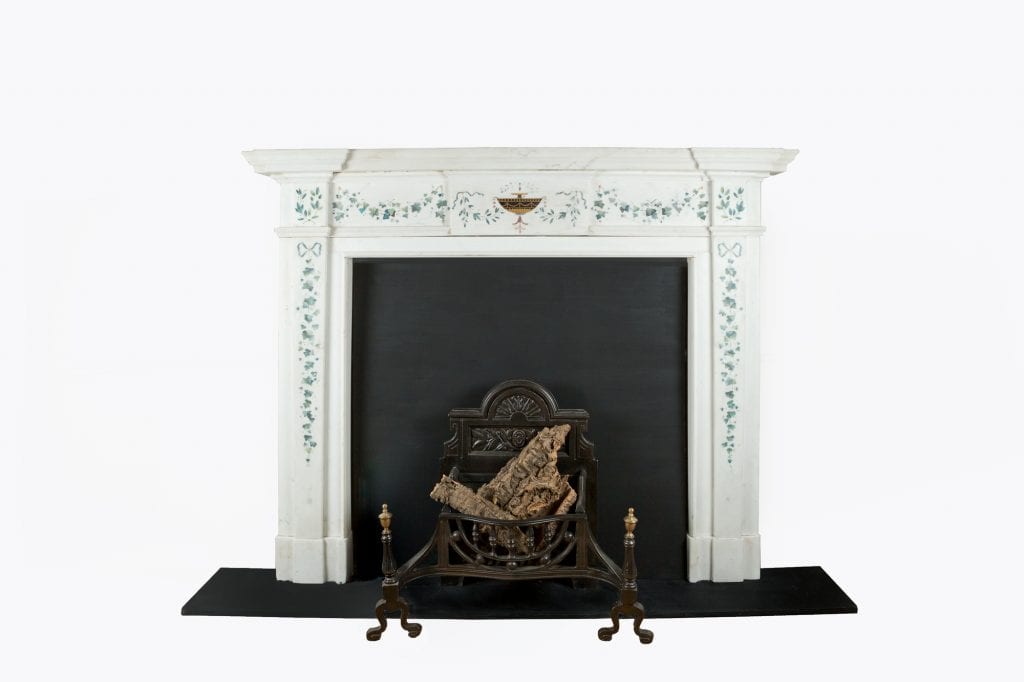The 18th Century Highly Skilled Masterly Craftsman of Fine Marble and Scagliola Fire Surrounds
Pietro Bossi, an 18th Century craftsman of fire surrounds of unprecedented talent, is most likely descended from a family of stucco workers from the Lake Como district in Italy. A move to Dublin in the latter period of the 18th Century, where upon he was listed in the Dublin Directories as an ‘Inlayer in Marble and Stucco Worker’ at 22 Fleet Street in 1785 and at 38 Fleet Street in 1787-98, greatly contributed to the beauty of design within the Georgian period of Ireland. Bossi was renowned for his Neoclassical fire surrounds with exquisitely detailed inlaid marble work and specialist craftsmanship in stucco and scagliola. The finesse of Bossi’s detail in scagliola was exceptional. Exquisitely depicted Neoclassical motifs of foliage, fruit and urns were portrayed in graduated colour with a sophisticated three dimensional depth.
This 18th Century George III Irish Neoclassical statuary white marble and scagliola fire surround is in the manner of Pietro Bossi, the inverted breakfront moulded mantle shelf is raised above a frieze with central tablet depicting classical urn with gadroon, linen swag, ball and trailing bell husk motifs surrounded with ribbon tied trailing stylised wheat sheaves. Flanked with frieze tablets with ivy swag and foliate wreath detail, the entire supported over pilaster with ribbon and trailing entwined ivy leaves terminating on moulded plinth block base.
Scagliola, a term derived from the Italian scaglia, meaning ‘chips’, is a type of fine plaster used in architecture and sculpture. The same term identifies the technique for producing columns, sculptures, and other architectural elements that resemble inlays in marble. The scagliola technique dates back to the classical era of Ancient Rome, however the highly skilled technique came to perfection during the Italian Renaissance of the 15th and 16th Centuries. A period which saw a revived passion for the perfection of the arts of the Classical Antiquities. However, the regular use of Scagliola reached its highest levels of popularity in the architecture of the Italian Baroque period and was continuously recreated through the 17th to 19th centuries in Europe in Italian style marble fireplaces for the aristocracy and the very elite.
Scagliola was used initially to copy the hugely expensive spectacular work done in Pietre Dure inlay, and then to create the enormous marble-like columns and architectural features that we see in our grandest buildings throughout Europe. These latter works would have been undertaken by large teams of travelling craftsmen, whereas there were also a small number of individuals such as Hugford, Gori and Belloni who made inlay work so fine it resembled painting.
Bossi has a number of table tops attributed to him in the Etruscan manner. The red figure medallian relate to the motifs on two fire surrounds are attributed to Bossi, one which is in situ at Charlemont House, a Dubin City Gallery also known as ‘The Hugh Lane Gallery’, whilst the other resides at at Castletownshend, Co. Cork.
It is generally thought that Bossi work and his medallions were inspired by William Hamilton from his catalogue of Etruscan, Greek and Roman antiquities from the Cabinet of the Hon W. Hamilton by Baron Pierre Hughes. In respect of the marble top tables, they are said to have been in the collection of the Dukes of Leinster thus they were either in Carton or Leinster House. The Leinster tables are possibly referred to in a Saunders Newsletter dated to 22 March 1786. The sales description from is as follows, ‘Peter Bossi, Inlayer of Marble, lately removed to no. 38 Fleet-street, has now for sale an elegant pair of statuary marble tables, also chimney pieces to be as good workmanship as any done in London. Apply as above.” Finally, a recent discovery in the Papers of Aldoborough House revealed an estimate was issued by Bossi for services of stucco and plaster work. In 1796 Bossi submitted an estimate to the second Earl of Aldborough for plastering and stucco work for Aldborough House, Dublin. It is also said that Bossi also made several mantelpieces for the house. The superb scagliola work of Pietro Bossi, remains some of the most desirable and collectable of Irish 18th Century decorative arts. His work continues to reach staggering prices at auction both at home and abroad.
It is interesting to also note the foreign influence felt in Dublin during the Georgian period and the lasting effect they have had on the aesthetic of this small outpost of Western Europe.

